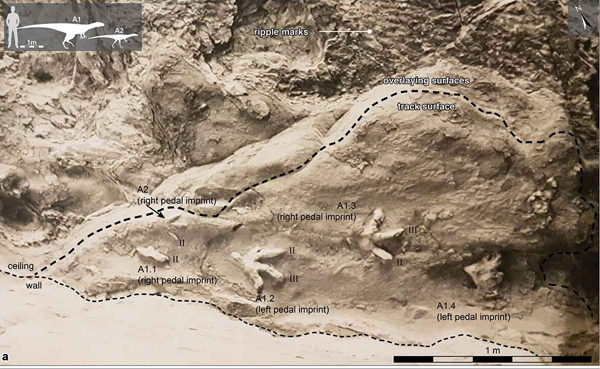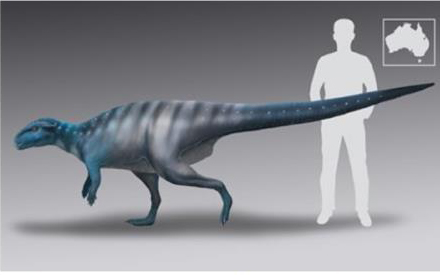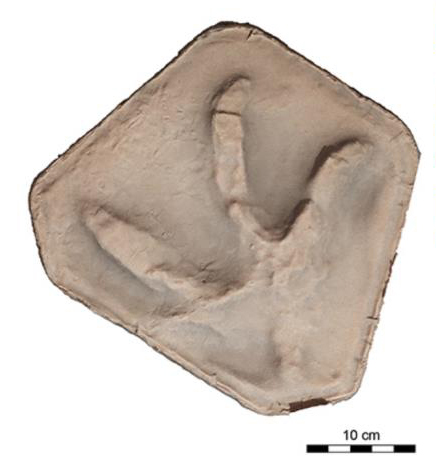A Dinosaur in the Cupboard Under the Stairs
Thanks to a dedicated geologist and the careful conservation of his materials and notes a sixty-six-year-old mystery about dinosaur footprints on a cave ceiling in Queensland (Australia), has been solved. Palaeontologist Dr Anthony Romilio (University of Queensland), was able to decipher and interpret a series of dinosaur trackways preserved in Lower Jurassic strata, now exposed on a cave ceiling with the help of notes, photographs and casts of the prints stored in a cupboard under the stairs of a house in Sydney.
Dinosaur Footprints on the Ceiling
The Dinosaur Tracks from the Cave Ceiling (Insert Shows Estimated Size of Track Makers)

Picture credit: Historical Biology
Dr Romilio, of the School of Chemistry and Molecular Sciences (University of Queensland) explained:
“The town of Mount Morgan near Rockhampton has hundreds of fossil footprints and has the highest dinosaur track diversity for the entire eastern half of Australia. Earlier examinations of the ceiling footprints suggested some very curious dinosaur behaviour; that a carnivorous theropod walked on all four legs.”
There have been hundreds of dinosaur tracks reported from the so-called “fireclay caverns” in Mount Morgan. Five prints first described by Ross Staines, the geologist who made such careful notes (1954), purportedly represent a theropod dinosaur that had left a handprint (manus), the interpretation was that this theropod had been walking on all fours. Most theropods are characterised by their obligate bipedal stance. Dr Romilio set out to determine whether this particular track did indeed preserve this very untypical theropod dinosaur behaviour. Unfortunately, it was not possible to access the trace fossils “in situ”, the caverns have been closed since 2011 due to concerns about public safety.
A Line Drawing Showing the Five Tracks Studied
Picture credit: Historical Biology
Unable to view the fossils in the cave, it would have been difficult to determine what the tracks represented.
A Stroke of Good Fortune
However, Dr Romilio had a chance meeting with local dentist Dr Roslyn Dick, whose geologist father found many dinosaur fossils over the years.
Ms Dick commented:
“I’m sure Anthony didn’t believe me until I mentioned my father’s name – Ross Staines. Our father was a geologist and reported on the Mount Morgan caves containing the dinosaur tracks in 1954. Besides his published account, he had high-resolution photographs and detailed notebooks, and my sisters and I had kept it all. We even have his dinosaur footprint plaster cast stored under my sister’s Harry Potter cupboard in Sydney.”
A Digitally Reconstructed Dinosaur Track Created from the Archive Material Compiled by Ross Staines
Picture Credit: Dr Romilio (University of Queensland)
Extensive Notes and Meticulous Records
The extensive information archived by Ross Staines and carefully stored by Ms Dick and her sisters Heather Skinner and Janice Millar, permitted Dr Romilio to conduct a thorough analysis of the trace fossils. He was able to digitise the original analogue photographs and to make a virtual, computer-generated model of the dinosaur track that had been stored under the stairs. As a result, it was concluded that the five tracks were all foot (pes) impressions and that no handprint was present.
It turns out that these tracks do not represent the prints of a single dinosaur, but actually two dinosaurs produced the five tracks, one slightly smaller than the other, which led to the misinterpretation of one of the footprints as being the preserved impression of a dinosaur hand. The splayed toes and moderately long middle digit of the footprints permitted the researcher to determine that these were probably not the footprints of a theropod, but that the tracks represent the progress of a pair of ornithopods.
Dr Romilio commented:
“Rather than one dinosaur walking on four legs, it seems as though we got two dinosaurs for the price of one – both plant-eaters that walked bipedally along the shore of an ancient lake.”
Dinosaur Footprints Mystery Solved
Thanks to the careful conservation of their father’s work, this is one Australian dinosaur trackway mystery that has been solved. These tracks do not represent a theropod dinosaur walking in an uncharacteristic quadrupedal gait, as Dr Romilio explained:
“You don’t assume T. rex used its arms to walk, and we didn’t expect one of its earlier predatory relatives of 200 million years ago did either.”
The contribution of the ladies has been recognised, they are all cited as co-authors/contributors to the scientific paper. We are sure their father would have been very proud.
A Life Reconstruction of the Larger of the Two Ornithopod Dinosaurs Believed to Have Made the Tracks

Picture credit: Dr Anthony Romilio
Dinosaurs Walking on the Ceiling?
How did the trace fossil end up on the ceiling of a cave? The dinosaurs were not defying gravity, the explanation is very straight-forward. The dinosaurs were walking on the soft sediment associated with a lake around 195 million years ago (Sinemurian faunal stage of the Lower Jurassic), the impressions they made in the soft sediments were infilled with sand. Over time, the softer mudstone and shales were eroded away to expose the imprints as natural casts.
A Photograph of Ross Staines Measuring the Dinosaur Tracks
Picture credit: University of Queensland
Everything Dinosaur acknowledges the assistance of a media release from the University of Queensland in the compilation of this article.
The scientific paper: “Archival data provides insights into the ambiguous track-maker gait from the Lower Jurassic (Sinemurian) Razorback beds, Queensland, Australia: evidence of theropod quadrupedalism?” by Anthony Romilio, Roslyn Dick, Heather Skinner and Janice Millar published in the journal Historical Biology.
Visit the Everything Dinosaur website: Everything Dinosaur.









Leave A Comment